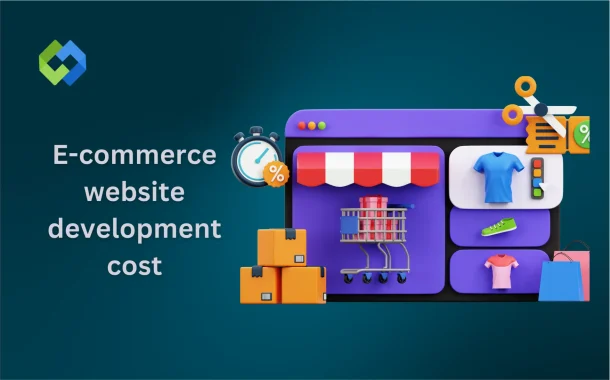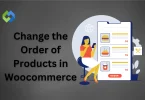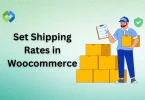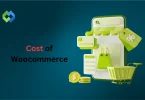Factors like increasing internet penetration, smartphone usage, and digital payment options have contributed to this growth. However, there are also challenges, such as logistics and payment security. Despite this, e-commerce is becoming more popular among Pakistanis.
People buy various things online, from clothing and electronics to groceries and books. Younger generations are particularly active in online shopping. Traditional businesses also recognize the importance of having an online presence. The government is working on regulations to ensure fair and secure e-commerce practices.
Table of Contents
Table of Contents
Factors Affecting Ecommerce Website Development Cost
The factors that affect e-commerce website development costs are as follows.
Website Design and User Experience (UX)
The design of an e-commerce website is critical as it directly impacts user engagement and conversion rates. Custom-designed websites with unique layouts, graphics, and branding elements typically incur higher costs than pre-made templates.
These design features might cost more upfront, but they usually lead to higher conversion rates and happier customers. If you want to add content marketing to your e-commerce site without spending too much on custom coding, tools like DropinBlog can help. They make it easy to add a blog, improve SEO, and boost customer engagement without increasing development costs.
Functionality and Features
The complexity and number of features desired for the e-commerce website significantly influence development costs. Standard features include product catalog management, shopping cart functionality, secure checkout processes, order management systems, and customer account dashboards.
Advanced functionalities like integration with third-party services (e.g., shipping carriers, CRM systems), multi-currency support, and personalized recommendation engines require additional development effort and investment.
Content Management System (CMS) Selection
Choosing a CMS platform for building the e-commerce website impacts development costs and long-term maintenance. Open-source CMS options like WordPress with WooCommerce, Magento, or Drupal offer flexibility and customization. However, they may require more development time and expertise.
On the other hand, hosted platforms like Shopify or BigCommerce provide user-friendly interfaces and built-in features but may need more customization and scalability. Custom-built solutions offer maximum flexibility but usually involve higher upfront costs and ongoing maintenance expenses.
Payment Gateway Integration
Secure payment gateways for processing online transactions are crucial for e-commerce websites. The selection and integration of payment gateways such as PayPal, Stripe, or local payment processors involve development work. They may require adherence to specific compliance standards (e.g., PCI DSS).
Some payment gateways charge setup fees, transaction fees, or monthly subscriptions, which should be considered in the overall development budget.
Security Measures
Ensuring the security of customer data and transactions is paramount for e-commerce websites. Implementing robust security measures such as SSL/TLS encryption, secure payment processing, firewalls, and regular security audits incur additional development costs.
Compliance with industry standards such as the Payment Card Industry Data Security Standard (PCI DSS) may involve extra expenses but is essential for protecting sensitive information and maintaining customer trust.
Mobile Responsiveness
With the proliferation of mobile devices, having a mobile-responsive ecommerce website is imperative. Responsive design ensures the website adapts seamlessly to various screen sizes and devices, providing an optimal user experience.
Developing a mobile-friendly website involves additional design and development effort, including responsive layout design, performance optimization, and cross-device testing, which may increase development costs.
SEO Considerations
Building an e-commerce website with search engine optimization (SEO) in mind is essential for attracting organic traffic and improving visibility in search engine results. Factors such as site structure, URL optimization, metadata optimization, mobile friendliness, and page load speed impact SEO performance.
Incorporating SEO best practices during website development requires additional effort in keyword research, content optimization, and technical implementation, which may add to development costs but are critical for long-term success.
Cost Breakdown of E-commerce Website Development
Design Costs (Approx. 15-25% of Total Budget)
- Graphic Design: Creating visually appealing elements such as logos, banners, and promotional graphics. Cost varies based on the complexity of design requirements and the designer’s expertise.
- UI/UX Design: Designing intuitive user interfaces and ensuring a seamless user experience. Includes wireframing, prototyping, and usability testing.
- Responsive Design: Optimizing the design to ensure consistent and optimal viewing experiences across various devices and screen sizes, including desktops, laptops, tablets, and smartphones.
Development Costs (Approx. 40-60% of Total Budget)
- Front-end Development: Writing code for the user-facing aspects of the website, including layout, navigation, and interactive elements using HTML, CSS, and JavaScript.
- Back-end Development: Building the server-side infrastructure using programming languages like PHP, Python, or Node.js and integrating with databases to manage product listings, user accounts, and transactions.
- Integration with Third-party Services: Connecting the website with external services such as payment gateways (e.g., PayPal, Stripe), shipping providers (e.g., UPS, FedEx), and inventory management systems.
- Custom Features Development: Developing unique functionalities tailored to the specific needs of the e-commerce website, such as advanced search filters, personalized recommendations, and loyalty programs.
Content Creation Costs (Approx. 5-15% of Total Budget)
- Product Photography: Hiring a professional photographer or purchasing stock photos to capture high-quality images of products. Cost varies based on the number of products and the complexity of the photography setup.
- Product Descriptions: Crafting engaging and informative descriptions for each product, highlighting key features, benefits, and specifications.
- Content Writing: Creating compelling content for landing pages, category pages, blog posts, and other website sections to enhance SEO and attract customers.
Hosting and Domain Costs (Approx. 5-10% of Total Budget)
- Domain Registration: Registering a unique domain name for the website through domain registrars like GoDaddy, Namecheap, or Google Domains.
- Hosting Services: Renting server space from hosting providers like Bluehost, SiteGround, or AWS to store website files and make them online accessible.
- SSL Certificate: Purchasing an SSL certificate to encrypt data transmitted between the website and its visitors, ensuring secure communication and protecting sensitive information.
Maintenance Costs (Approx. 10-20% of Total Budget)
- Software Updates: Keeping the website’s CMS, plugins, and other software components updated to patch security vulnerabilities and add new features.
- Security Monitoring: Implementing measures to detect and prevent cyber threats like malware, hacking attempts, and data breaches.
- Technical Support: Providing ongoing assistance and troubleshooting for website issues, including server maintenance, performance optimization, and bug fixes.
- Content Updates: Regularly update product listings, prices, promotions, and other website content to keep information accurate and relevant.
Additional Costs
- E-commerce Platform Fees: Monthly subscription fees for using hosted e-commerce platforms like Shopify, BigCommerce, or a Magento platform, which provide built-in features and support.
- Marketing and Advertising: Budget for promoting the website through various channels such as social media advertising, email marketing, search engine optimization (SEO), and pay-per-click (PPC) advertising.
- Analytics and Reporting Tools: Investment in tools and services for tracking website performance, analyzing user behavior, and generating reports to inform marketing strategies and decision-making.
Average Ecommerce Website Development Costs in Pakistan
These are just estimates; actual costs can vary based on specific needs and requirements.
Small Business E-commerce Websites
- Cost Range: Typically, it can cost between PKR 50,000 and PKR 200,000.
- Description: These websites are basic and suitable for small businesses. They include essential features like displaying products, a simple shopping cart, secure checkout, and basic design.
Medium-Sized Business E-commerce Websites
- Cost Range: The cost usually falls between PKR 200,000 to PKR 500,000.
- Description: These websites are more advanced and cater to medium-sized businesses. They offer features such as user accounts, product reviews, better search options, and some customization in design.
Large Enterprise E-commerce Websites
- Cost Range: Costs can range from PKR 500,000 to over PKR 2,000,000.
- Description: These websites are highly customized and serve large companies. They have complex features like integration with other business systems, advanced security measures, high-traffic scalability, and extensive design work to enhance user experience.
Comparison of Different E-commerce Platforms
Shopify
- Description: Shopify is a hosted e-commerce platform known for its user-friendly interface and extensive feature set. It offers various themes, customizable designs, and built-in tools for managing products, orders, and payments.
- Pros: Easy to set up and use, no technical expertise required, reliable hosting, extensive app store for additional functionalities, built-in marketing tools.
- Cons: Transaction fees on specific payment gateways, limited customization options compared to open-source platforms, ongoing subscription costs.
WooCommerce (WordPress)
- Description: WooCommerce is an open-source e-commerce plugin for WordPress websites. It allows users to turn their WordPress sites into fully functional online stores with customizable themes, extensive plugins, and flexibility.
- Pros: Highly customizable, vast selection of themes and plugins, integration with WordPress content management system, no transaction fees (besides payment gateway fees).
- Cons: It requires a WordPress website (additional hosting costs), more technical knowledge is required for setup and customization, and security and performance may need to be managed separately.
Magento
- Description: Magento is a robust open-source e-commerce platform suitable for large enterprises and businesses with complex requirements. It offers advanced features, scalability, and flexibility for creating customized online stores.
- Pros: Highly scalable and customizable, extensive feature set, suitable for large catalogs and high traffic, robust security features.
- Cons: Higher development and maintenance costs, the technical expertise required for setup and customization, and hosting and infrastructure costs can be significant.
BigCommerce
- Description: BigCommerce is a cloud-based e-commerce platform that provides a comprehensive solution for building and managing online stores. It offers a range of features, including hosting, payment processing, and marketing tools.
- Pros: All-in-one solution with hosting included, easy setup and management, built-in SEO and marketing features, scalable for growing businesses.
- Cons: Limited customization options compared to open-source platforms, transaction fees on specific plans, and less flexibility for developers.
Custom Development
- Description: Custom development involves building an e-commerce website from scratch or heavily customizing existing platforms to meet specific business needs. It offers complete control over features, design, and functionality.
- Pros: Tailored to unique business requirements, unlimited customization options, no restrictions on features or scalability.
- Cons: Higher upfront costs and development time, ongoing maintenance and support required, may need technical expertise for management and updates.
Tips for Cost-Effective E-commerce Website Development
- Strategic Feature Selection: Prioritize essential features directly contributing to sales and customer satisfaction. Avoid adding unnecessary features that can inflate development costs without significant benefit. Conduct market research to identify the features most valued by your target audience.
- Efficient Resource Utilization: Utilize pre-designed templates and themes to save time and money on website design. Opt for open-source platforms like WooCommerce or Magento Community Edition to avoid high licensing fees. Consider DIY options for basic tasks and outsource complex development tasks if needed.
- Optimization for Performance: Invest in optimizing website performance to reduce load times and improve user experience. Compress images, enable caching, and leverage content delivery networks (CDNs) to speed up page loading. Ensure responsive design to provide a seamless experience across different devices and screen sizes.
- Scalability Planning: Choose a scalable platform and architecture to accommodate growth without costly redevelopments. Plan for future expansion by selecting flexible solutions and anticipating increased traffic and transaction volumes. Implement modular design and architecture to facilitate easy scalability as the business grows.
- Cost-Efficient Marketing Strategies: Focus on cost-effective marketing tactics such as content marketing, social media engagement, and email campaigns. Utilize accessible or affordable SEO, analytics, and email marketing tools to minimize marketing expenses. Monitor marketing ROI and adjust strategies based on performance to maximize effectiveness within budget constraints.
Conclusion
The costs of creating an e-commerce website in Pakistan are vital for businesses. We’ve looked into factors like design, features, and maintenance influencing costs. By being mindful of these aspects and adopting cost-effective strategies, businesses can build quality websites within their budget. Despite the initial investment, a well-designed website can increase sales and better customer engagement.
Different e-commerce platforms offer flexibility to choose according to needs and budget. Staying updated with technology and consumer trends is crucial for sustained growth. Regular maintenance and marketing efforts are also essential for success in Pakistan’s evolving e-commerce landscape.














